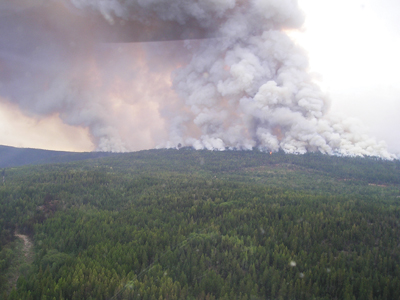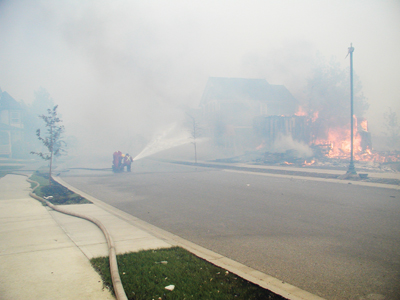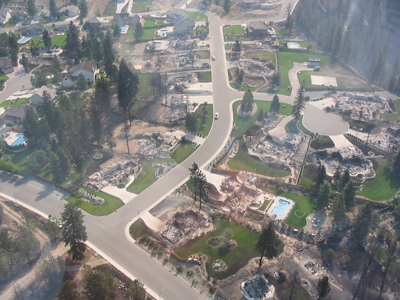
Features
Hot topics
Wildfire Week
Firestorm 2003
Canada is a forested nation, with more than 400 million hectares of forest or about 10 per cent of the Earth’s total forest area. Every year, thousands of wildland fires burn across million of hectares. While these fires have not yet reached the level of recent fires in Australia or the U.S. southwest, they do affect thousands of people, have a significant impact on local and regional economies and clearly demonstrate the potential for a major disaster.
June 1, 2009
By Paul Dixon
Canada is a forested nation, with more than 400 million hectares of forest or about 10 per cent of the Earth’s total forest area. Every year, thousands of wildland fires burn across million of hectares. While these fires have not yet reached the level of recent fires in Australia or the U.S. southwest, they do affect thousands of people, have a significant impact on local and regional economies and clearly demonstrate the potential for a major disaster.
 |
| The 2003 fire season was the worst on record in B.C., with more than 250,000 hectares destroyed.
|
The wildland/urban interface is any place where structures are in close proximity to combustible wildland fuels. This includes large parks and green belts within urban settings, subdivisions built adjacent to forests or rangelands, and/or small communities or industrial properties in isolated locations surrounded by forests. No two wildfires are the same, because the factors that influence these fires are never exactly the same. The type, amount and moisture content of fuel, precipitation, relative humidity, temperature and wind conditions at the time of the fire, as well as the topography over which the fire burns, all have an influence on shaping the development of the fire.
In the summer of 2003 in British Columbia, more than 250,000 hectares were consumed in the worst fire season on record. Entire towns were evacuated and hundreds of homes were destroyed. In October 2003 Gary Filmon, former premier of Manitoba, was appointed by the B.C. government to head an independent inquiry into the province’s.
Filmon’s mandate was to review the issues relevant to prevention, planning and response to wildfires. Public hearings were held in eight of the communities most affected by the fires. Hundreds of submissions were heard. Filmon’s report, released in the spring of 2004, highlighted many previously identified areas of concern, emphasizing that if nothing were done, the future danger would be even greater. Filmon made recommendations on mitigation, response and recovery, forest management practices, emergency management planning and implementation, command and control issues, communications issues and resources from both the human and materiel perspectives.
 |
|
| With resources spread thin, Kelowna firefighters try to save a home next door to a structure consumed by the wildland/urban interface fire. | |
 |
|
| The wildland/urban interface fire of 2003 ravaged the city of Kelowna and surrounding area. (Photo by Kelowna Assistant Fire Chief Lou Wilde)
|
■ Learning the hard way
South of Kelowna, the city of Penticton was one of the key operations centres during the 2003 fire season. Initially, Penticton served as a staging point for firefighters and apparatus arriving from the rest of the province. Firefighters and equipment would then be sent north, up the east side of Okanagan Lake, through Naramata to the Okanagan Mountain fire zone, or south to Okanagan Falls and the Vaseux Lake fire. Penticton Fire Chief Wayne Williams has vivid memories of that summer.
“When the OK Mountain fire forced the evacuation of Naramata, their EOC was consolidated into the Penticton EOC in the No. 1 fire hall. It was at this point when we created one fire department comprising the 13 communities in the Regional District of Okanagan Similkameen and the municipal firefighters that responded from other areas of the province. Eventually, the EOC grew in size and complexity to where it took over the entire fire headquarters building, forcing the fire apparatus and crews to move to the No. 2 hall on the other side of town. Power to the entire region was lost when hydro lines from the north were consumed in the OK Mountain fire and the lines from the south were affected by the Vaseux Lake fire. We didn’t have adequate backup power and it was a challenge sourcing and placing generators. Then, at the height of the fire threat, a small plane crashed in the middle of the Penticton watershed, threatening the quality of the city’s drinking water.”
Williams relates some of the steps that have been taken since the summer of 2003.
“The primary EOC is now in our city hall, with the regional district office designated as the secondary EOC. One very positive thing that came out of that summer was the performance of the city and regional district staff in the EOC. Many staff members stepped in and performed tasks far outside of their training and backgrounds. They did a great job. Now, we’ve been able to augment that experience with formal training.”
In 2007, a series of windstorms toppled trees and knocked out power over much of the Okanagan Valley, but with emergency generators in place, fire department operations and communications were unaffected.
All Penticton firefighters have been trained and equipped for fighting interface fires. “We have outfitted all firefighters, career and paid on-call, with coveralls, hard hats, boots and eye protection. Everyone has their bag with them at all times” says Williams.
A positive relationship with the provincial ministry of forests has enabled Penticton to engage the services of local helicopter operators for fire fighting on the strength of a phone call. “Previously, it might have taken several hours to get a helicopter on to a fire.” Now, says Williams, “we can have a helicopter bucketing within minutes of the fire being reported.”
■ Elevation
Unlike Penticton’s semi-arid climate, West Vancouver lies in B.C.’s temperate coastal rainforest. Stretching along the north shore of English Bay from the Lions Gate Bridge to Horseshoe Bay and up Howe Sound, West Vancouver has Canada’s most expensive residential real estate nestled in amongst the forests that extend from sea level up through Cypress Bowl to an elevation in excess of 1,600 metres. While development is restricted to the first 350 metres above sea level, the municipality stretches over much of the forested mountainsides above, to where they become provincial parkland and the Metro Vancouver watershed.
Bill McCuaig is the urban forester for District of West Vancouver. While the untrained eye sees trees stretching from sea level to mountain top, McCuaig has a very different view. A wildfire that kills most of the vegetation within an area is called a “catastrophic” or “stand-replacement” fire. More common are the fires that burn through a stand killing some, but not all, of the existing trees and under canopy vegetation. In B.C.’s coastal rainforests, the necessary weather conditions to create fires are infrequent when compared to the hot, dry interior of the province. However, low-elevation forests become warmer and drier than high-elevation forests and are subsequently more susceptible to fire. Evidence indicates that the high-elevation forest on Hollyburn Ridge, high above West Vancouver, has experienced just two stand-replacement fires since the last ice age – 10,00 to 12,000 years ago – while the 75-hectare Lighthouse Park, at sea level, has experienced such fires as frequently as every 250 years. McCuaig says that there have been many fires in Lighthouse Park over the past 15 years, as many as 18 in one year and every one caused by humans – some caused by the carelessness of a discarded cigarette or abandoned campfires and other deliberate acts of vandalism.
■ Public education
West Vancouver Fire & Rescue Division Chief Martin Ernst is responsible for public education, inspections and enforcement.
“We take a very proactive approach to public education, especially in promoting the idea that people must be responsible for taking the necessary steps to protect their homes,” he says.
“It’s much easier to prevent a fire than it is to fight a fire. We do have authority within our municipal bylaws to compel property owners to take appropriate steps to minimize fuel loading on their property and our residents are not reluctant to phone in complaints. To date, we’ve never had to take formal action, as we find people are very quick to comply when the dangers are pointed out. When we investigate these complaints we make a point of meeting with the complainant, as it gives us a chance to do some further education. We try to teach people the concept of making their property defensible.”
While West Vancouver firefighters are trained in wildland firefighting techniques and have the tools and equipment to fight fires in the interface zone, they are still primarily structural firefighters. In the interface, the fire department takes primary responsibility for the areas within 350 metres of a road. That leaves a huge portion of the municipality beyond the fire department’s capabilities.
What sets West Vancouver apart from other communities is its parks department wildfire suppression crew. Under Bill McCuaig’s direction and a second supervisor, there are two three-person initial attack (IA) crews.
“We all have backgrounds as firefighters with the province”, says McCuaig, “though we all have full-time jobs in the parks department with fire fighting as a secondary responsibility.” All the parks firefighters are trained to provincial specifications, including helicopter entry/exit.
“In fire season”, McCuaig says, “we aim to be able to deploy our crews to a fire within 30 to 45 minutes. That means returning to the works yard from wherever they may be in the municipality and responding from there. When the fire hazard reaches moderate, two of our staff will be on pager 24/7. When the hazard level reaches high or extreme, all eight of us are on call 24/7.”
Beyond their own borders, at peak times in the summer fire season when provincial resources are redeployed from the southwest region into other areas of the province, the West Vancouver crews will be contracted by the province to respond to fires in the provincial parks and crown land adjoining West Vancouver, as well as work with the Metro Vancouver watershed protection wildland crews.
There is a strong working relationship between West Vancouver Fire & Rescue and the parks fire crews. While McCuaig is circumspect in saying that his staff are not trained as structural firefighters, Division Chief Ernst is more forthright in stating that there have been many instances in recent years whenwhere the timely assistance of parks crews in the interface zone has been invaluable. •
Print this page